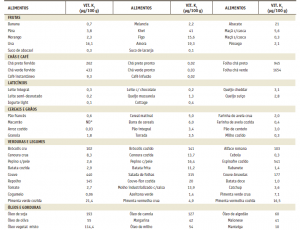
Fonte: guiadoculturismo
In previous publications we have mentioned about the vitamins A, C, D and E. In the current posting, the major theme is the contextualization of Vitamin K, and its relationship to physical exercise, aimed at information and reduce questions regarding this nutriente.
Vitamin K is known as soluble and was discovered in 1929 by Henrik Dam in a study with chickens, which could see bleeding as a characteristic sign of a diet free of fats.
Later, in 1935, it was reported by Dam the symptom was alleviated by ingesting a fat-soluble substance, which was named vitamin K or vitamin coagulation (Franco, 1999). The designation vitamin K comes from the first letter of the word Danish koagulation (Oliveira, 1998).
The vitamin K acts as a cofactor for carboxylation of specific glutamic acid residues to form gamma acid carboxyglutamic (Gla), amino acid present in clotting factors (factors II, VII, IX and X) (Elder et al., 2006).
Vitamin K works to aid the work of calcium in the body where there is evidence that vitamin K is important in early skeletal development and maintenance of healthy mature bone.
Food Sources

 Benefits
Benefits
In the most logical benefit, blood clotting, there are other benefits that should be taken into account in relation to this vitamin. They are: increased fertility, increased immunity, increased healing, increases sexual desire, combat presence in abundance of free radicals and helps in the treatment of abnormality in the breast development (very important for females). In adults, vitamin K deficiency in the body, it can show up through the nose bleeding, urine, stomach or even huge delay scarring that would normally be extremely fast.
Thus, vitamin K acts in accelerating the healing process and can assist in this way in the exercise, reducing troublesome from chafing (Stupiello, 2015).
Risks
In wasteful consumption of vitamin K can increase the risk of thrombosis, however, it is almost impossible that this fact occurs by means of feed. Excess vitamin can only occur in cases of oral supplementation without medical advice (Stupiello, 2015).


 Benefits
In the most logical benefit, blood clotting, there are other benefits that should be taken into account in relation to this vitamin. They are: increased fertility, increased immunity, increased healing, increases sexual desire, combat presence in abundance of free radicals and helps in the treatment of abnormality in the breast development (very important for females). In adults, vitamin K deficiency in the body, it can show up through the nose bleeding, urine, stomach or even huge delay scarring that would normally be extremely fast.
Thus, vitamin K acts in accelerating the healing process and can assist in this way in the exercise, reducing troublesome from chafing (Stupiello, 2015).
Risks
In wasteful consumption of vitamin K can increase the risk of thrombosis, however, it is almost impossible that this fact occurs by means of feed. Excess vitamin can only occur in cases of oral supplementation without medical advice (Stupiello, 2015).
Benefits
In the most logical benefit, blood clotting, there are other benefits that should be taken into account in relation to this vitamin. They are: increased fertility, increased immunity, increased healing, increases sexual desire, combat presence in abundance of free radicals and helps in the treatment of abnormality in the breast development (very important for females). In adults, vitamin K deficiency in the body, it can show up through the nose bleeding, urine, stomach or even huge delay scarring that would normally be extremely fast.
Thus, vitamin K acts in accelerating the healing process and can assist in this way in the exercise, reducing troublesome from chafing (Stupiello, 2015).
Risks
In wasteful consumption of vitamin K can increase the risk of thrombosis, however, it is almost impossible that this fact occurs by means of feed. Excess vitamin can only occur in cases of oral supplementation without medical advice (Stupiello, 2015).